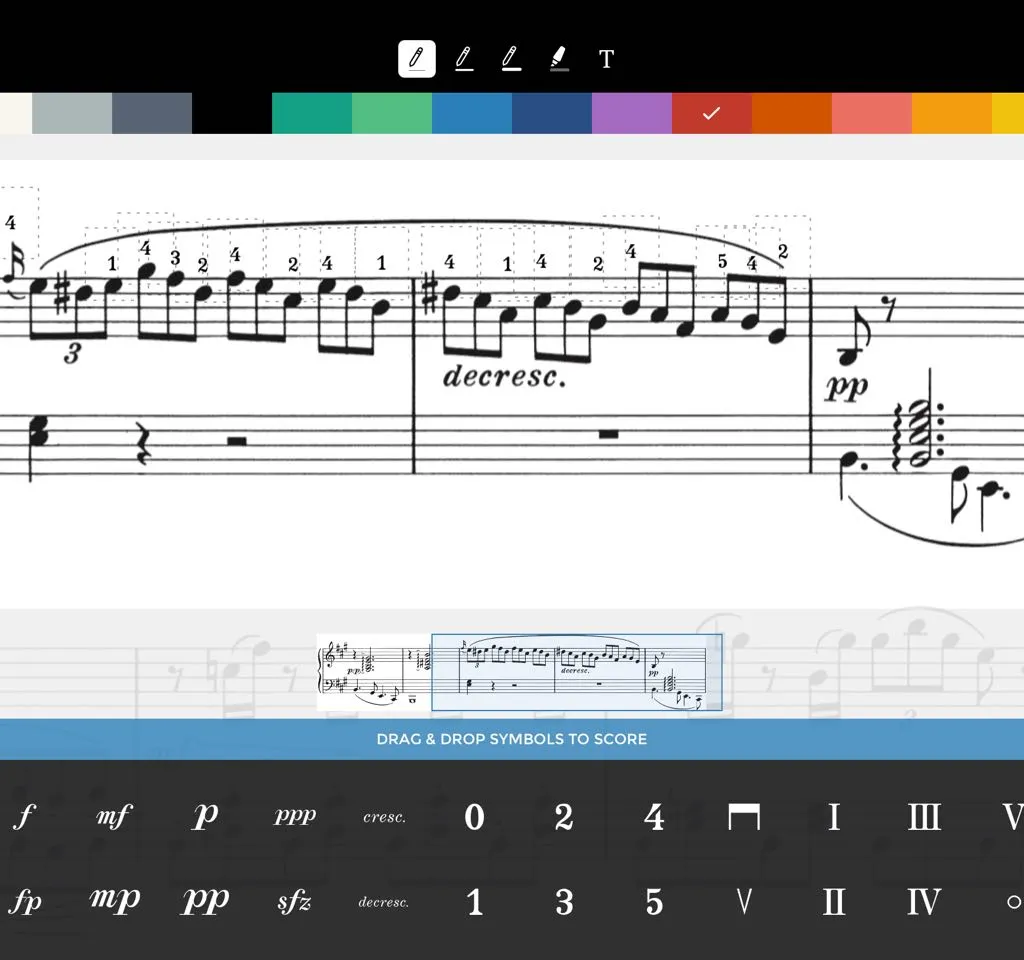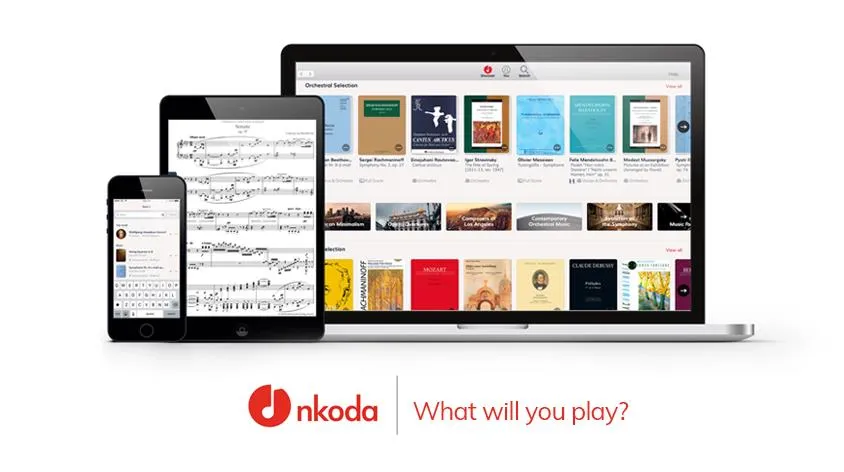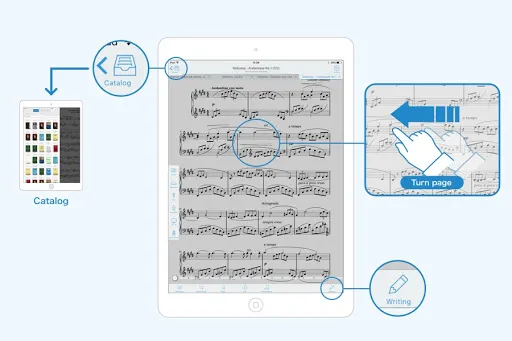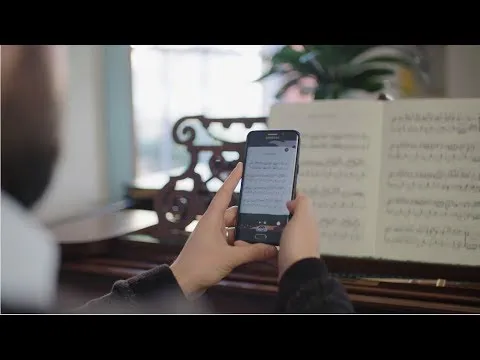I admit I’m a bit of a technophobe. Yes, I have a smartphone and an underused iPad mini, and I’m a little too addicted to Netflix. But when it comes to my professional life, I’m more analogue than digital.
Which is why, up until now, I’ve been sceptical about using a tablet for reading scores during both practice and performance. I’m a busy concert pianist and teacher, and have had little time for deciphering each of the many apps. I’ve also been terrified that a tablet might crash or run out of charge midway through a concert. But technology moves quickly and the time has finally come for me to overcome these fears and plunge headlong into the brave new world of score-reading apps.
For my trial, Apple kindly lent me an iPad Air. There are, of course, other tablets available, and most of these apps will work with them. But screen size is a major consideration for anyone wanting to read a score, and the iPad Air features a decent 250mm, crystal-clear screen. Musical notation can usually be increased or decreased but it’s worth saying at this juncture that, compared with sheet music, scores generally appear a little smaller on a tablet.
Even without apps you can do a lot on an iPad. Simply scan your own music in on the Notes app bundled with the iPad, save it and annotate it with an Apple Pencil (model allowing). But if that’s so easy to do, why use an app at all? Tablets in performance have become a major player in the music industry and are becoming increasingly popular. Many musicians now use them to download and buy scores, to perform and to share – and for that you need apps…
Henle
The Henle app was the first I downloaded, mainly because it’s one of my go-to editions. It has a store of over 100 scores (10 credits are 99p; 100 credits, £8.99; 500 credits, £38.99), including substantial volumes such as the complete Beethoven piano sonatas. It also enables you to download single parts independently. There’s a handy metronome feature and you can annotate and personalise your scores, saving or printing them as you wish.
I enjoyed customising my score layout and print size (which is useful for ensuring safe page turns), and in selected pieces it offers exclusive fingering and bowings from celebrated musicians. The ability to switch between your part and the full score is another important feature, especially with chamber music.
If you want to record your performance, chart your progress and add it to the library, you can do that too. Like most apps you can drag and drop symbols (dynamics, time signatures, etc) and there’s a metronome included, too. You can even jump back to the beginning of a piece or section when you reach a repeat sign, just by tapping with two fingers. I found this took a bit of getting used to, but it’s a useful extra.
Rating 7/10

forScore
When I asked friends and colleagues which apps they used, forScore was one of the most popular. There are several different methods to download your music to forScore and it’s easy to input markings with the Apple Pencil. I liked the way you can drag the tool bar down to the exact line you’re editing, which is particularly useful when you’re using small notation stamps (dynamics, sharps and flats etc) or icons. Personally, I’d prefer to write these in with the Apple Pencil, but they’re useful for making the script look neater.
If you’re not a fan of a loud metronome (when did we become so sensitive?) then you’ll love the app’s visual version; there’s also a pitch button, plus a tuning fork and a mini keyboard.
Among its many other functions, forScore allows you to export scores you’ve worked on and share them with others. I discovered that a few of the apps do this and, while not particularly relevant to me, I can see that it’s a valuable tool for ensembles. And if your device features Apple’s True Depth camera system, you can use facial gestures to turn pages, either by turning your head, winking or by moving your lips. I’d find this a bit unnerving on stage but it’s a great bonus to have at home.
Rating 8/10

Newzik
As a digital score-reading newbie, I needed help to get the most out of Newzik. There are a lot of functions here that aren’t applicable to me as a pianist but are terrific nonetheless. Band Mode, for instance, allows a group to connect screens together (you can lead or follow) and, like forScore, you can share your content with other musicians who have the same app.
You can organise your personal digital library from your iPad but you do need to scan each piece in, which you can easily do using the scanner within the app. There’s also a tool for purchasing music from a publisher, although currently only via Universal Edition. You can, however, also export your scores as a PDF, including all of your annotations. The library is possibly simpler to use than forScore’s, which makes it more attractive to me when adding all my scores to the app. On top of that, the app’s premium version allows you to import more and access the collaborative, screen-sharing feature.
But it’s also great being able to talk to someone in the Newzik team who will help musicians, orchestras and schools by visiting and giving them much-needed advice and support.
Rating 8/10

Nkoda
If you want a more extensive and diverse range of scores, I suggest you head to Nkoda – probably the most useful app for me. It has an outstanding library of over 100,000 titles from over 100 publishers which, as a pianist, is a useful and slightly addictive feature.
No sooner had I downloaded the app than I received a welcome email from Kieran, who went on to suggest repertoire and playlists, from Einaudi to Puccini – quite eclectic choices for a pianist, but a nice, if slightly unusual touch.
Nkoda describes itself as ‘a Spotify for sheet music’, a pretty accurate summary. Like most of the available apps you can annotate scores, bookmark pages and create playlists. If you are a collaborative pianist, needing to carry numerous scores, Nkoda would no doubt prove invaluable.
At £9.99 per month or £99 per year, I’d say it’s aimed more at the professional musician who is constantly needing to learn new repertoire.
forScore and Nkoda have some similarities, but overall I’d say forScore is more about the extras, whereas Nkoda’s big sell is its range of individual pieces.
Rating 9/10

Piascore
Piascore is another free app that’s easy to access. It shares a lot of features with forScore and Newzik, who are probably its main competitors.
I decided to download a Chopin nocturne and work on it, leaving my own paper score by the piano for reference. I loved the way you can split the score to make page turning easier, which would be hugely helpful for anyone learning the piece. One of my favourite features was its 3D metronome, like those wooden ones we used to own that usually had a mind of their own! If it appeals to you, the cheeky little metronome will hover over your score like a stern piano teacher, reminding you to keep in time.
Upgrades bring more functions and storage opportunities – £3.99, for instance, brings you its score-sharing function, music tools (keyboards, tuner) and unlimited camera capturing.
Like most other apps, you can keep your music library in an alphabetical list for easy reference. If you own the latest iPhone or an iPad Pro or later, you can use your facial gestures for page turning – wink and your page will turn!
Rating 7/10

Playscore
Playscore initially seemed complicated to open and install – it wasn’t immediately clear how to get into the app. But once I’d conquered that, it was brilliant and cleverly constructed. Take a picture of the score and the app will play it for you – with all the dynamics in place – at a tempo and instrumentation of your choosing.
As well as being fun to play with, this part of app reminded me (with some nostalgia) of an up-to-date version of the play-along Music Minus One recordings. But it’s absolutely vital that the quality of your original scan is high enough to get the best playback results.
You can access scores directly from ISMLP (International Music Score Library Project), or by exporting and sending them to Playscore 2 (Playscore 2 professional costs £29.99 for a year). I was bowled over by the ability to change a score’s instrumentation for a completely different playback, which I did with a string quartet. Totally brilliant.
Playscore is a great musical tool that behaves more like a musical spreadsheet. This means it’s perfect for sharing marked-up parts with others. Whether you’re a choirmaster, conductor or orchestral manager, it’s a real time-saver, and I can see many ways that this app could be indispensible.
Rating 9/10

Many of these apps share a multitude of similar functions with some working a degree or two more smoothly than others. But they’re all worth downloading as their costs are quite competitive. I gained a good deal of pleasure from simply roaming around each app and trying out its array of functions.
I’d definitely use the iPad for travelling and reference, and after living with one for a few months, I’m even happy to report I’ve turned a major corner in using it on the platform. I’m not sure I’m at the stage of using it for a major concert appearance, but at a more intimate event or chamber recital, you might even catch me on stage, winking for the page turns!
This article appeared in the April 2020 issue of BBC Music Magazine.
